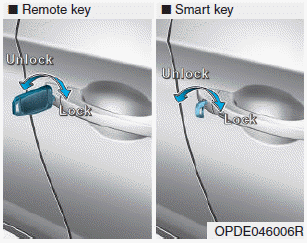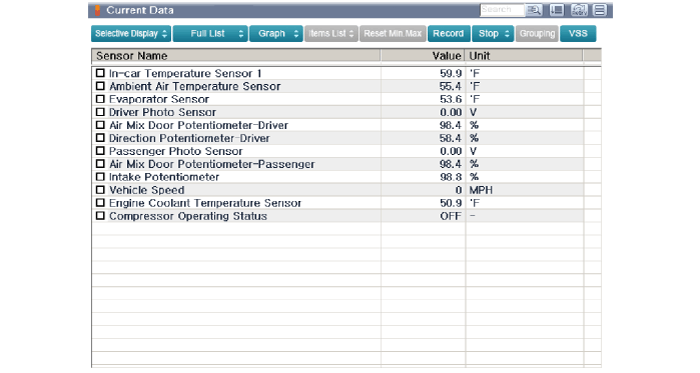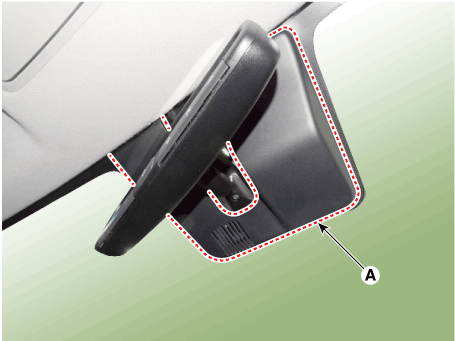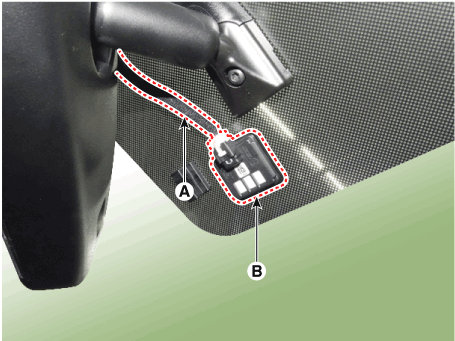Hyundai i-30: Air Conditioning System / Auto Defogging Sensor
Hyundai i30 (PD) 2018-2025 Service Manual / Heating, Ventilation and Air Conditioning / Air Conditioning System / Auto Defogging Sensor
Description and operation
| Description |
The auto defogging sensor is installed on the front window glass. The sensor
judges and sends signal if moisture occurs to blow out wind for defogging. The
air conditioner control module receives signal from the sensor and restrains
moisture and eliminate defog by controlling the intake actuator, A/C, auto defogging
actuator, blower motor rpm, and mode actuator.
Repair procedures
| Diagnosis With GDS |
| 1. |
The heating, ventilation and air conditioning can be quickly diagnosed
failed parts with vehicle diagnostic system (GDS).
※ The diagnostic system (GDS) provides the following information.
(1) Self diagnosis : Checking the failure code (DTC) and display.
(2) Current data : Checking the system input/output data state.
(3) Actuation test : Checking the system operation condition.
(4) Additional function : Other controlling such as he system option
and zero point adjustment.
|
| 2. |
Select the 'Car model' and the system to be checked in order to check
the vehicle with the tester.
|
| 3. |
Select the 'Current data' menu to search the current state of the input
/ output data.
The input / output data for the sensors corresponding to the Auto Defogging
Sensor can be checked.
|
| Replacement |
| 1. |
Disconnect the negative (-) battery terminal.
|
| 2. |
Remove the auto defogging cover (A).
|
| 3. |
Disconnect the connector (A) and then remove the auto defogging sensor
(B).
|
| 4. |
To install, reverse the removal procedure.
|
 Ambient Temperature Sensor
Ambient Temperature Sensor
Description and operation
Description
The ambient temperature sensor is located at the front of the condenser and
detects ambient air temperature...
 Cluster Ionizer
Cluster Ionizer
Components and components location
Components Location
1. Cluster lonizer
Description and operation
Description
The cluster ionizer makes disinfection and decomposition of bad smell from the
air-conditioner or inflow air...
Other information:
Hyundai i30 (PD) 2018-2025 Owner's Manual: Indicator lights
When the ignition switch is in the ON position, the ESC indicator light illuminates, then goes off if the ESC system is operating normally. The ESC indicator light blinks whenever the ESC is operating. If the ESC indicator light stays on, your vehicle may have a malfunction with the ESC system...
Hyundai i30 (PD) 2018-2025 Owner's Manual: System malfunction
Check FCA (Forward Collision Avoidance Asst.) When the FCA is not working properly, the FCA warning light () will illuminate and the warning message will appear for a few seconds. After the message disappears, the master warning light () will illuminate...
Categories
- Manuals Home
- 3rd Generation i30 Owners Manual
- 3rd Generation i30 Service Manual
- Auto door lock/unlock features
- Exhaust System (DPF) Warning Light. Glow Indicator Light
- Scheduled maintenance services
- New on site
- Most important about car
Door locks
Operating door locks from outside the vehicle
Mechanical key

Turn the key toward the rear of the vehicle to unlock and toward the front of the vehicle to lock.
If you lock/unlock the driver's door with a key, a driver’s door will lock/unlock automatically.
Copyright © 2025 www.hi30.net



